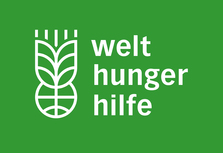Location
Welthungerhilfe is one of the largest private aid organisations in Germany, independent of politics and religion. It was established in 1962, as the German section of the "Freedom from Hunger Campaign", one of the world's first initiatives aimed at the eradication of hunger.
What we do
We fight for the eradication of hunger and poverty. Our aim is to render our work unnecessary. We provide aid from a single source: From rapid disaster relief to long-term development cooperation projects. In 2015, we were able to support 7.3 million people with 387 overseas projects in 40 countries. Since its establishment, Welthungerhilfe has supported more than 8,120 overseas projects with around 3.03 billion Euro, 5,746 of which have been self-help projects (more facts and figures in the latest annual report).
How we work
Help to self-help is our guiding principle; together with local partner organisations we strengthen structures on a grassroots level and ensure a long-term success of our projects. Moreover, we inform the public and advise politics – nationally and internationally. We thus fight for change of the circumstances that lead to hunger and poverty.
Members:
Resources
Displaying 11 - 15 of 272014 Global hunger index: The challenge of hidden hunger
With one more year before the 2015 deadline for achieving the Millennium Development Goals, the 2014 Global Hunger Index report offers a multifaceted overview of global hunger that brings new insights to the global debate on where to focus efforts in the fight against hunger and malnutrition. The state of hunger in developing countries as a group has improved since 1990, falling by 39 percent, according to the 2014 GHI.
L’Indice de la faim dans le monde 2014: Le défi de la faim invisible
Alors qu’il ne reste plus qu’une année avant la date d’échéance de la réalisation des Objectifs du Millénaire pour le développement, l’Indice de la faim dans le monde 2014 (GHI) offre une analyse multidimensionnelle de la faim et présente de nouvelles données permettant d’alimenter le débat mondial sur la question de savoir où concentrer les efforts dans la lutte contre la faim et la malnutrition. Selon le GHI 2014, les niveaux de faim dans les pays en développement pris dans leur ensemble se sont améliorés depuis 1990, diminuant de 39%.
Indice Globale della Fame 2014: la sfida della fame nascosta
A un anno dalla scadenza per il raggiungimento degli Obiettivi di Sviluppo del Millennio, fissata nel 2015, l’Indice Globale della Fame 2014 offre una prospettiva articolata del problema della fame nel mondo, che porta nuovi spunti al dibattito mondiale rispetto a dove concentrare gli sforzi nella lotta contro la fame e la malnutrizione. Secondo il GHI 2014, lo stato della fame nei Paesi in via di sviluppo è complessivamente migliorato in confronto al 1990, con un calo del 39%.
Welthunger-Index 2014: Herausforderung verborgener Hunger
Ein Jahr bevor die Frist zur Erreichung der Millenniums-Entwicklungsziele im Jahr 2015 abläuft, bietet der Welthunger-Index (WHI) einen facettenreichen Überblick über die Verbreitung des Hungers und trägt neue Erkenntnisse darüber in die weltweite Debatte, wie Hunger und Mangelernährung verringert werden können. Betrachtet man die Entwicklungsländer als Gruppe, so hat sich die Hungersituation dort seit 1990 verbessert. Dem WHI 2014 zufolge ist seitdem ein Rückgang um 39 Prozent zu verzeichnen.
2013 Welthunger-Index : Herausforderung Hunger : Widerstandsfähigkeit stärken Ernährung sichern
Die globale Hungersituation hat sich seit 1990 verbessert, wie der Welthunger-Index 2013 anhand von Daten aus dem Zeitraum 2008-2012 zeigt. Der WHI ist um ein Drittel gesunken. Dennoch ist die weltweite Hungersituation nach wie vor „ernst“. 870 Millionen Menschen hatten laut Schätzungen der Ernährungs- und Landwirtschaftsorganisation der Vereinten Nationen (FAO) im Mittel der Jahre 2010-2012 nicht genug zu essen. Südasien und Afrika südlich der Sahara haben die höchsten WHI-Werte.






